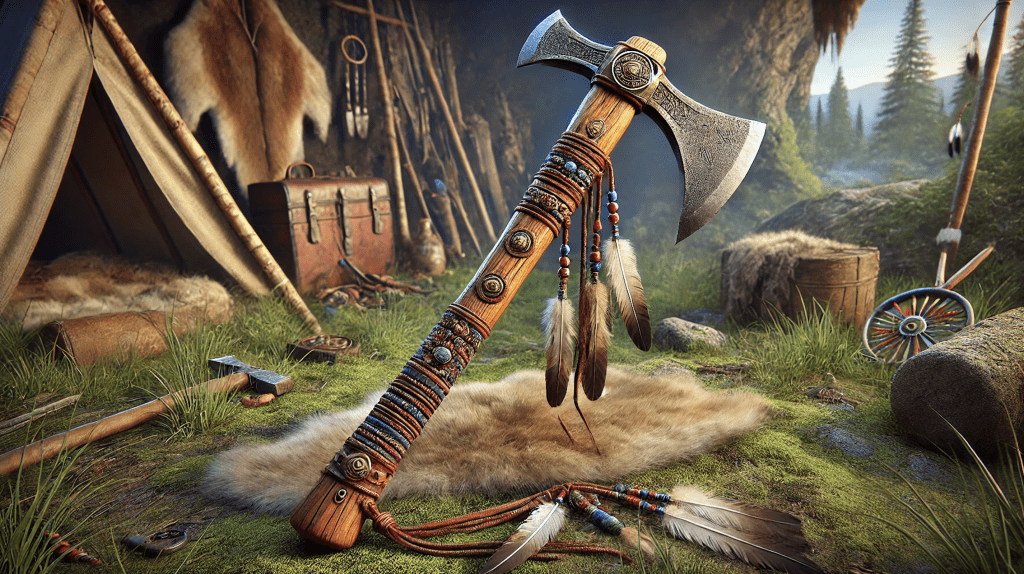When stepping into the great outdoors or delving into the world of bushcraft, selecting the right tools is crucial. Among the array of gear available, the tomahawk stands out as a tool with deep historical roots and a wide range of uses. More than just a tool, a tomahawk is a versatile companion suited for a variety of tasks in the wilderness. This article will explore what a tomahawk is, its various uses, its historical origins, and why it continues to be a preferred tool for serious bushcrafting today.
What is a Tomahawk
A tomahawk is a small, lightweight axe that was traditionally used by Native American tribes and early European settlers in North America. Distinctive in its design, the tomahawk features a thin, straight handle and a compact axe head, which differs significantly from the broader, heavier heads of conventional axes. The handle, typically crafted from robust hardwoods such as hickory or ash, is straight and allows for a comfortable grip. One of the unique aspects of a tomahawk’s construction is how the head is attached: it’s held on by a friction fit due to the eye of the axe head tapering. This tapering design allows the head to grip the handle firmly without the need for additional fasteners, making the tomahawk both durable and easy to maintain.
Historical Origins: Where Did Tomahawks Come From
The tomahawk’s origins can be traced back to the indigenous peoples of North America, particularly within the regions that are now known as Canada and the United States. The word “tomahawk” is derived from the Algonquian word “tamahak,” which referred to a striking tool. Originally, tomahawks were made from sharpened stones tied to wooden handles using natural fibers or animal sinew. With the arrival of European settlers, these tools underwent a significant transformation. The Europeans introduced metalworking skills, and soon, tomahawks were being crafted with iron or steel heads, greatly improving their effectiveness and durability.
Tomahawks were not only practical tools but also played significant roles in the cultural and spiritual lives of Native Americans. They were used in rituals, as symbols of peace during treaty negotiations, and also as formidable weapons in battle. As the tool spread among European settlers, it became a symbol of the American frontier—embodying the spirit of exploration, self-reliance, and adaptability.
How Can a Tomahawk Be Used
The versatility of the tomahawk is what truly sets it apart from other tools. Its design allows it to perform a multitude of functions, making it indispensable for survivalists, campers, homesteaders, and bushcrafters. Here’s a deeper look into some of its core uses:
- Cutting and Chopping: At its most fundamental level, the tomahawk serves as an effective cutting tool. Its lightweight and narrow head allow for precise cutting and chopping tasks, such as trimming branches, cutting down small trees, or preparing kindling for a fire. The design provides control, enabling more precise cuts compared to heavier axes, which are better suited for brute force chopping.
- Splitting Wood: The tomahawk’s removable handle offers a unique advantage when it comes to splitting wood. By removing the handle, the head of the tomahawk can be used as a splitting wedge. This is particularly useful for dividing larger logs into smaller, more manageable pieces. When hammered into the end grain of a log, the wedge can create a clean split, an essential skill for preparing firewood in the wilderness.
- Skinning and Processing Game: The sharp, narrow blade of a tomahawk is ideal for skinning animals and processing game. The ability to remove the handle and use the head alone allows for a high degree of control, making it easier to remove fur and skin without damaging the underlying muscle or hide. This feature is particularly valuable for hunters and trappers who need to prepare hides for clothing or trade.
- Hammering and Prying: The flat side of a tomahawk’s head can be effectively used as a hammer for driving stakes, nails, or breaking through ice. Additionally, the tomahawk can serve as a makeshift pry bar for lifting or separating objects. This dual-purpose functionality reduces the need to carry multiple tools, which is an advantage when weight and space are at a premium.
- Self-Defense and Throwing: Historically, tomahawks were also used as weapons, both in close combat and as throwing weapons. The balance and design of the tomahawk make it suitable for self-defense situations in the wild. Additionally, the sport of tomahawk throwing has gained popularity, highlighting the tool’s aerodynamic design and balance.
Why Choose a Tomahawk for Bushcrafting?
When considering tools for bushcraft, the tomahawk offers distinct advantages over traditional axes and hatchets. Its lighter weight makes it less cumbersome to carry on long treks, reducing fatigue and allowing for greater mobility. The straight handle design, compared to the often-curved handles of other axes, is easier to grip and provides better control, especially for intricate tasks.
The friction-fit handle also provides a significant benefit in terms of maintenance and versatility. Because the handle is not permanently attached, it can be easily replaced in the field if it breaks—a common occurrence in rugged environments. Unlike other axes, where a broken handle might render the tool useless without proper equipment to replace it, a tomahawk’s handle can be quickly fashioned from a sturdy branch, keeping the tool functional.
The Superior Choice for True Bushcrafting
For serious bushcrafting, the tomahawk is a superior choice due to its adaptability and ease of use. Unlike heavier axes designed primarily for chopping large trees or splitting heavy logs, the tomahawk is designed to be multifunctional. Its narrower, sharper blade allows it to handle a range of tasks, from woodcarving to preparing food, without the excessive weight and bulk of a larger axe. This makes it a more efficient choice for those who practice bushcraft, where the philosophy is to do more with less.
Moreover, the tomahawk’s design encourages a greater connection with the environment and the tasks at hand. Its versatility requires the user to develop a wide range of skills, from crafting replacement handles to using the tool for a variety of purposes—skills that are at the heart of bushcrafting and outdoor survival.
Closing Thoughts
In summary, the tomahawk is not merely a relic from the past but a tool that has evolved and adapted to meet the needs of its users throughout history. From its origins with Native American tribes to its transformation by European settlers and its continued use by modern outdoors enthusiasts, the tomahawk embodies versatility, durability, and practicality. Its unique design, which allows for a range of applications—from chopping wood and skinning game to splitting logs and serving as a self-defense tool—makes it a valuable asset for anyone venturing into the wilderness.
For those looking to embrace true bushcrafting, the tomahawk is more than just a practical tool; it’s a connection to a long tradition of ingenuity and survival. By understanding its history, design, and uses, one can appreciate why the tomahawk remains relevant and highly valued in today’s outdoor and bushcraft communities. As you prepare for your next adventure, consider the tomahawk not just as a tool but as a reliable companion that has stood the test of time.





















